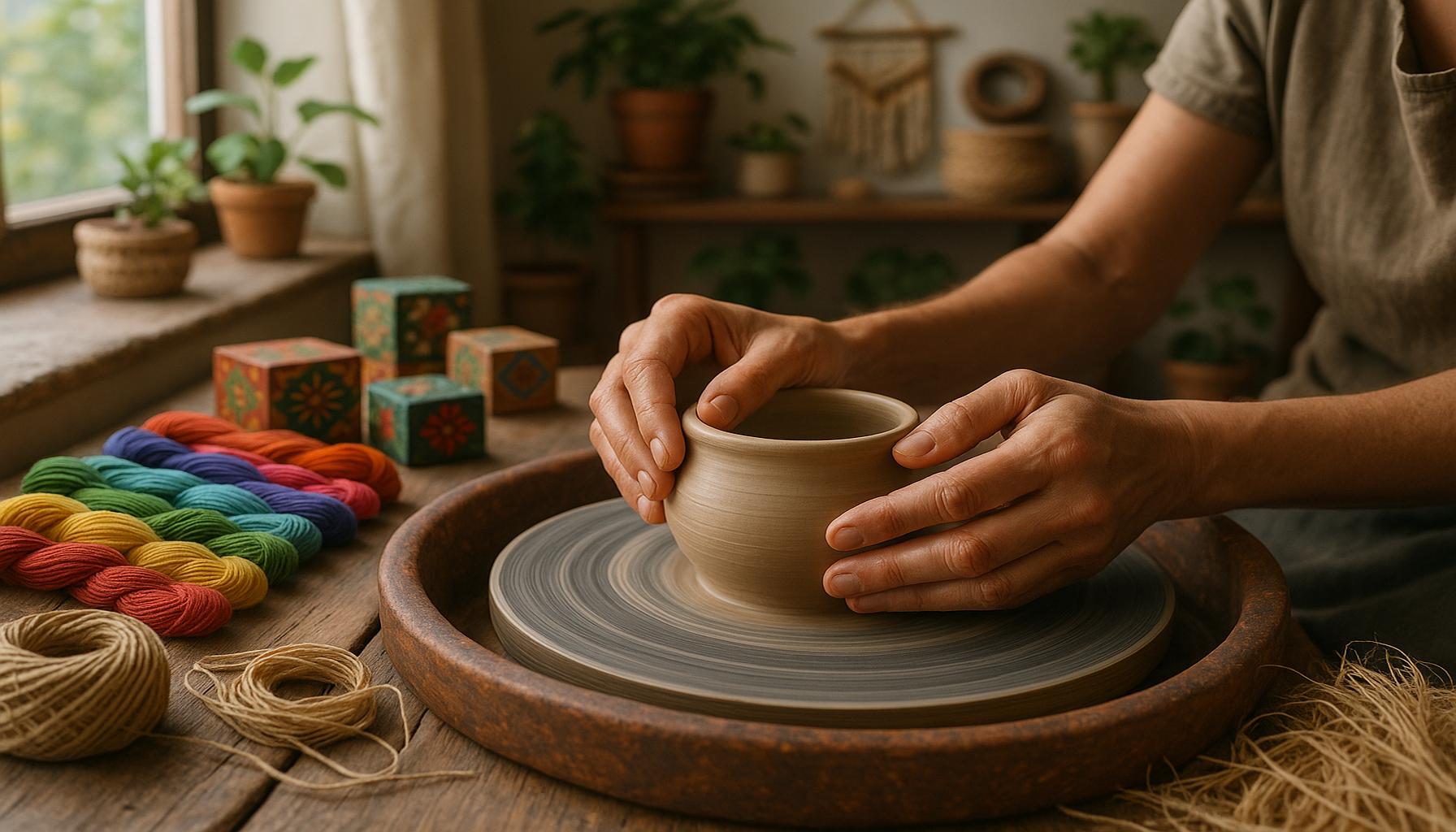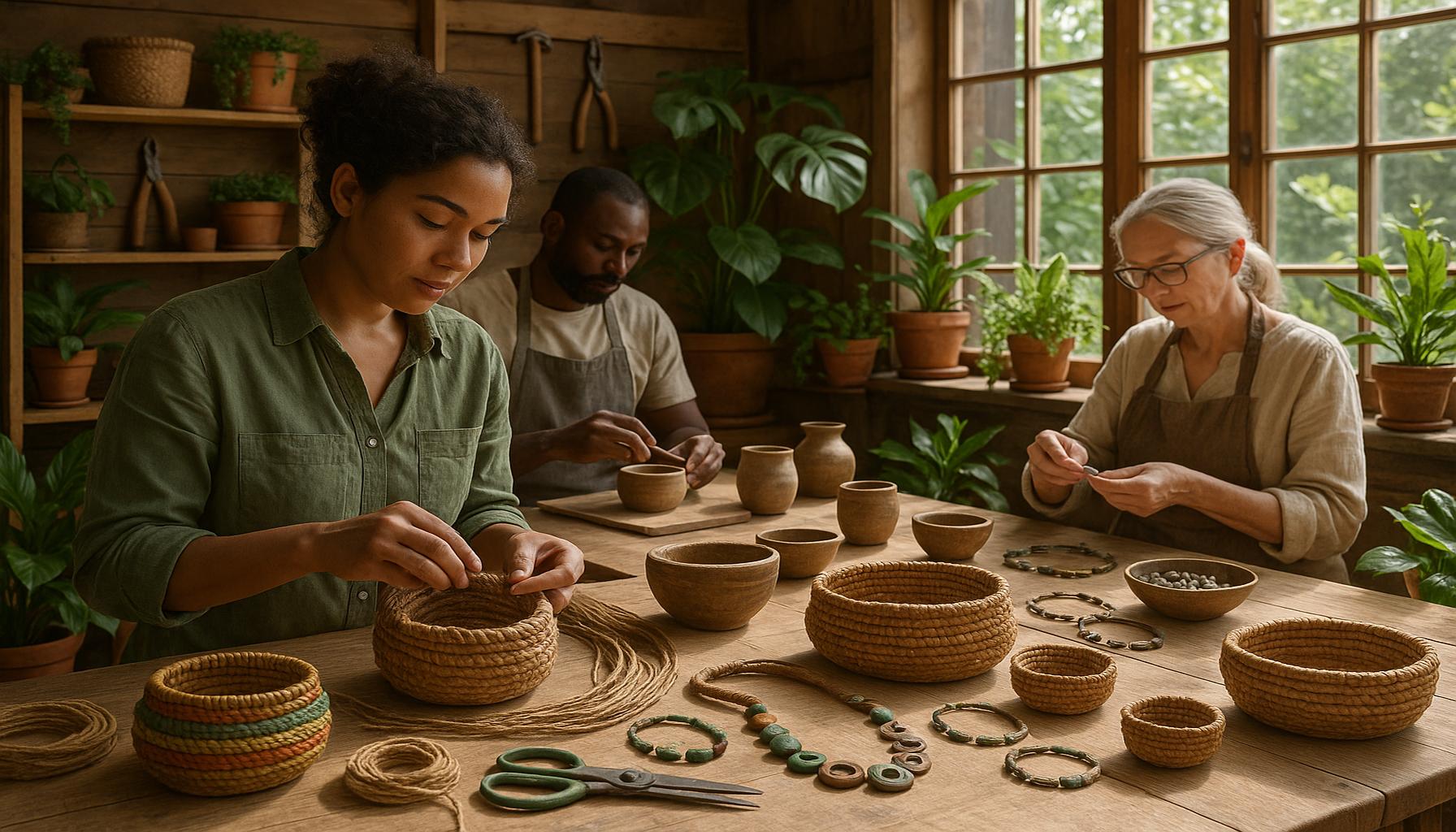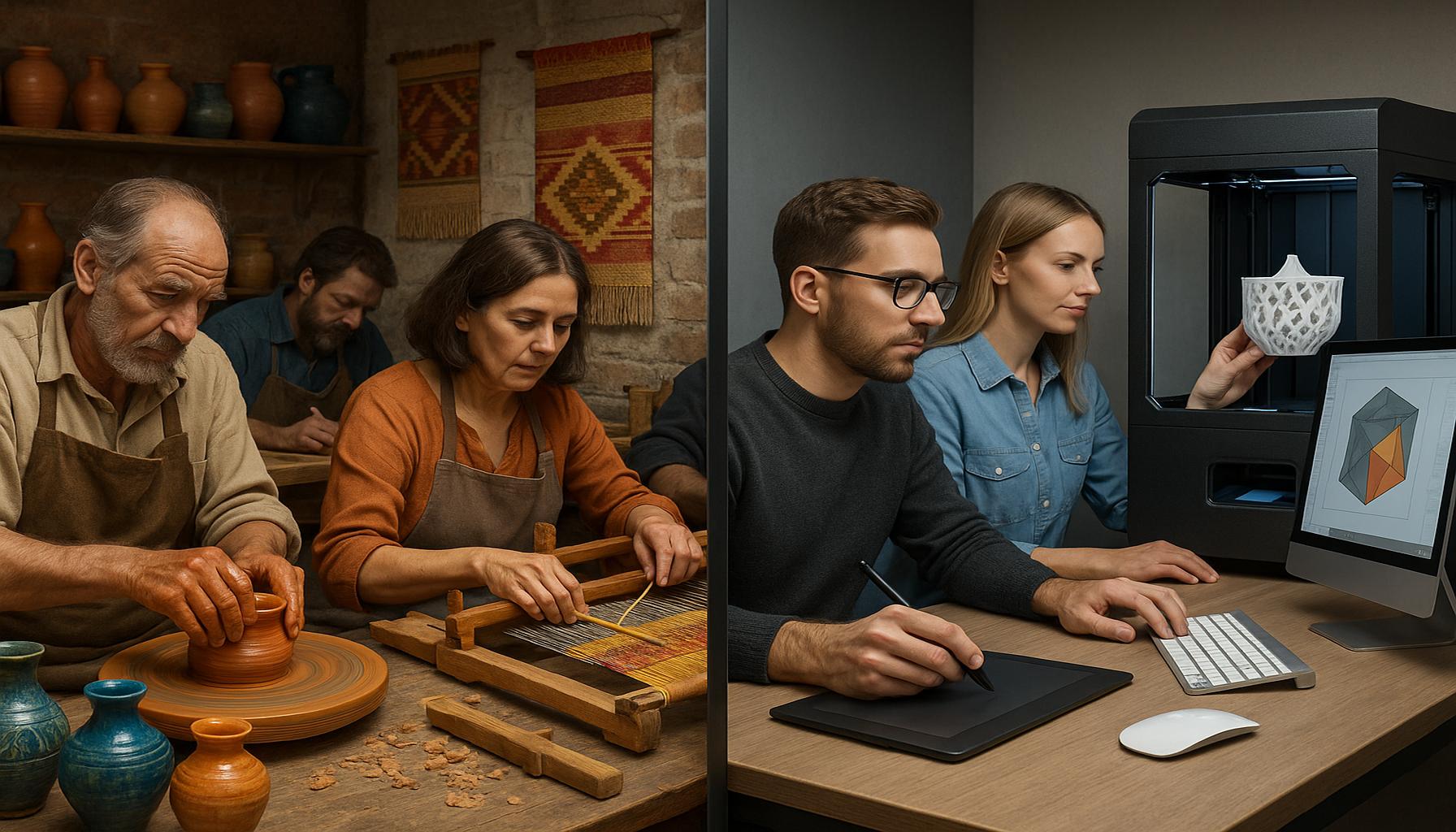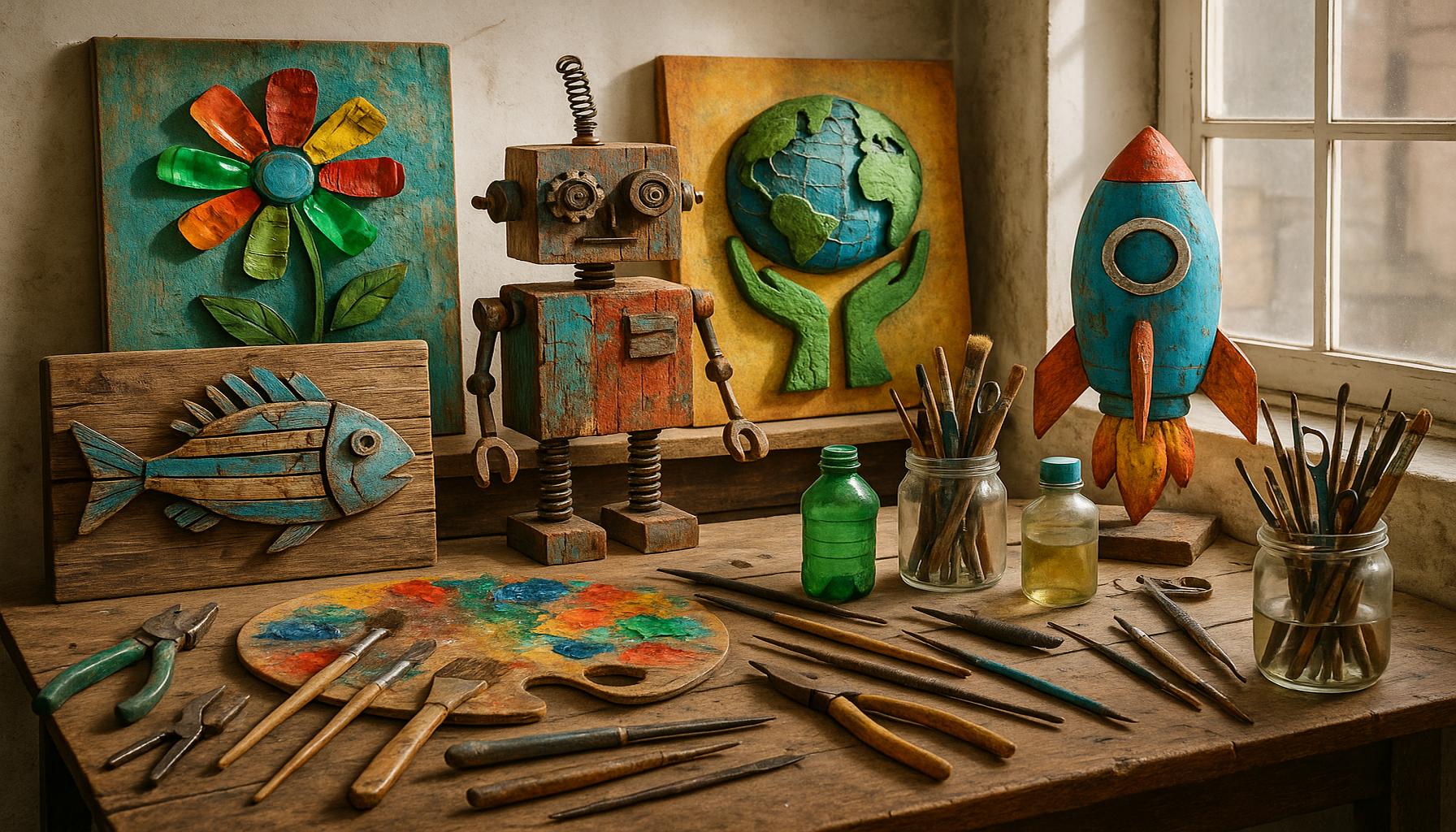Craftsmanship and Well-Being: The Connection Between Manual Creativity and Mindfulness

The Intersection of Handcrafted Creativity and Mindfulness
In today’s hyperconnected environment, the relentless pace of life often leaves little room for tranquility. However, the resurgence of interest in craftsmanship can serve as a beacon of solace. Engaging in various forms of handmade arts not only allows individuals to channel their creative energies but also fosters a practice of mindfulness—an invaluable approach to enhancing mental health.
The creative process in itself can be an antidote to the chaos of modern life. By taking the time to engage in manual activities, we can establish a connection to the present moment, which is essential for mental clarity. Let’s delve into some popular crafts that exemplify this relationship:
- Knitting and crocheting: These crafts are not only enjoyable but also therapeutic. The repetitive hand movements have been likened to meditation, providing a calming effect that reduces stress and anxiety levels. Numerous studies suggest that engaging in these activities can lower cortisol levels, a hormone associated with stress. Imagine sitting in a cozy corner, with the soft clanking of needles and the rhythm of yarn slipping through fingers—this is a practice that nourishes the soul.
- Woodworking: The meticulous nature of woodworking demands focus and precision. Each cut and carve requires a deep attention to detail, leading artisans to experience a profound sense of achievement once the project is completed. Moreover, the sensory engagement involved—touching the wood, smelling the shavings—enhances mindfulness, encouraging practitioners to savor the moment.
- Painting and drawing: These forms of artistic expression not only stimulate the imagination but also offer a safe space for emotions to flow. Whether through bold strokes on canvas or delicate sketches, engaging in art can help clear mental clutter and promote emotional processing. For many, art serves as a language of its own, a way to convey feelings that may be difficult to articulate.
What makes craftsmanship so unique is its potential to cultivate substantial benefits beyond the immediate act of creating. Engaging with crafts can yield:
- Enhanced creativity and problem-solving skills: The act of creating often involves trial and error, which can translate into improved creative thinking and resilience in other areas of life.
- A sense of accomplishment and self-worth: Completing a project—from beginner to advanced—instills pride and boosts self-esteem.
- Meaningful social connections: Crafting can often lead to community building, whether in classes, clubs, or online platforms, where individuals share tips, techniques, and camaraderie.
As we explore the rich relationship between manual creativity and mindfulness, we uncover a pathway to greater health, happiness, and connection with others. By actively seeking out and engaging in creative pursuits, individuals can unlock therapeutic benefits while enriching their lives and the lives of those around them.
This journey into craftsmanship not only brings personal satisfaction but may also inspire others to join in. Therefore, consider picking up a craft or revisiting an old hobby; the rewards may be more significant than you ever anticipated.
DISCOVER MORE: Click here to uncover how music enhances creativity
The Therapeutic Effects of Manual Crafts
Engaging in craftsmanship goes beyond merely creating aesthetically pleasing objects; it serves as a powerful tool for fostering well-being through enhanced mindfulness. As individuals immerse themselves in the tactile experience of crafting, they embark on a sensory journey that encourages them to slow down and appreciate the present moment. This focus on the here and now can profoundly impact mental health, counteracting the distractions and stresses of everyday life.
Research indicates that activities such as pottery, sewing, and sculpting offer unique pathways to mindfulness. When individuals attach their hands to the creative process, they shift their awareness from external worries to internal peace. This alignment of mind and body cultivates a state of flow—a psychological concept that arises when one becomes fully absorbed in an activity. For many artisans, this moment of complete involvement can be a significant departure from their often hectic routines.
- Clay Work: Molding clay is not just an artistic endeavor; it is a form of active meditation. Each motion of the hands shapes and transforms the material, grounding the practitioner in physical sensation. Studies have shown that engaging with clay can help relieve anxiety, providing both an emotional outlet and a therapeutic space for self-expression.
- Leather Crafting: The intricate process of working with leather involves precise techniques that demand focus. As artisans cut, stitch, and mold the leather, they develop a heightened awareness of their surroundings, including the texture and scent of the material. This sensory engagement promotes mindfulness, reducing feelings of overwhelm.
- DIY Home Projects: Home improvement projects, whether it’s building furniture or simple decorations, offer a personal touch to living spaces while cultivating mindfulness. The satisfaction derived from transforming a vision into reality fosters a sense of accomplishment, promoting emotional well-being. Moreover, these hands-on activities can serve as collaborative efforts with family and friends, enhancing interpersonal bonds.
The focus on craftsmanship also plays a significant role in emotional healing. Engaging in manual activities can help individuals process emotions that might otherwise feel overwhelming. For example, individuals recovering from loss or trauma often find solace in the creative endeavor, allowing them to express their feelings without the need for words. The act of crafting becomes a form of therapy, providing a safe outlet for emotions.
As we explore the therapeutic aspects of manual creativity, it becomes clear that the impact on well-being extends beyond the moment of creation. The skills honed through crafting—such as patience, dedication, and attention to detail—can reverberate throughout other areas of life, leading to greater emotional resilience and overall fulfillment.
Ultimately, the act of creating by hand not only serves individual practitioners but can also encourage a cultural renaissance of appreciation for craftsmanship, connecting people to a time-honored tradition that celebrates both artistry and mindfulness. The profound benefits of these practices encourage communities to nurture creativity as a vital part of holistic well-being.
| Advantages | Description |
|---|---|
| Enhanced Focus | Engaging in manual creativity requires concentration, promoting a state of mindfulness. |
| Emotional Well-Being | Craftsmanship can act as a stress reliever, helping individuals express emotions and achieve a sense of satisfaction. |
| Personal Growth | Through creating, individuals often discover unexpected talents and foster self-esteem. |
| Community Connection | Participating in craft activities can build relationships and enhance social skills. |
The profound connection between craftsmanship and well-being lies in how manual creativity fosters a pathway toward achieving mindfulness. Engaging in handcrafted activities can significantly boost your focus. As you immerse yourself in the details of a project, you enter a state of deep concentration, a fundamental aspect of mindfulness practices. This improved focus can serve as a refuge from daily distractions, allowing for moments of tranquility.Moreover, manual creativity contributes substantially to emotional well-being. The act of crafting serves as a therapeutic outlet, enabling individuals to express their feelings and navigate emotional complexities. This aspect of craft not only alleviates stress but also cultivates a profound sense of satisfaction upon completion of a piece. Beyond immediate benefits, this journey into craftsmanship can inspire profound personal growth. As individuals explore their creative potential, they often stumble upon hidden talents, instilling a sense of accomplishment and boosting self-esteem. Additionally, engaging in craft-oriented activities fosters a sense of community, promoting connections with like-minded individuals while enhancing social skills.In essence, the multifaceted advantages of craftsmanship and its connection to well-being beckon readers to explore this enriching endeavor further and discover its transformative power in their own lives.
DISCOVER MORE: Click here to unlock the secrets of art’s impact on mental well-being
The Social and Community Benefits of Craftsmanship
Beyond individual mental health advantages, the practice of craftsmanship fosters a sense of community that can further enhance well-being. Crafting creates opportunities for social engagement, serving as a bridge between people of diverse backgrounds. Whether it’s through local workshops, community artisans’ fairs, or online crafting forums, these platforms promote shared experiences and collective creativity. This connectivity not only nurtures relationships but also reinforces social networks, providing individuals with a support system fundamental to mental well-being.
Group crafting activities, such as knitting circles or pottery classes, allow participants to bond over shared interests. The simple act of creating in a group can reduce feelings of isolation and loneliness, which are prevalent in today’s fast-paced and often digitally driven world. According to a study published in the Journal of Community Health, engaging in group activities yields a marked improvement in participants’ emotional health, satisfaction, and overall sense of belonging. In a society where loneliness rates are rising, these facets of social crafting are increasingly relevant.
- Quilting Bees: Historically, quilting bees have been a powerful communal event, allowing participants not only to create beautiful works of art but also to share stories and life experiences. These gatherings often provide emotional support and serve as an informal network for advice on both crafting techniques and personal challenges, building strong communal ties.
- Maker Spaces: These community-oriented workshops have proliferated across urban and suburban areas, providing access to tools and materials for a range of crafts. They invite individuals of all skill levels to collaborate, learn, and innovate together. This shared space cultivates inclusivity and diversity, allowing participants to learn from one another, share skill sets, and engage collaboratively, enhancing both social interaction and creative expression.
- Craft Fairs and Markets: Such events not only provide artisans with the chance to showcase their handiwork but also foster community involvement. Consumers are given the opportunity to connect with local creators, supporting small businesses while forming relationships within their community. This form of economic and social engagement can enhance local pride and contribute to a shared identity.
Furthermore, the social dynamics that arise from crafting have been shown to have profound impacts on psychological well-being. Participating in craft-related projects stimulates the release of endorphins, promoting feelings of happiness and reducing stress levels. A study by the American Journal of Public Health highlighted that individuals engaged in community-building crafts showed significantly lower levels of anxiety and depression over extended periods. This interplay between manual creativity and social support exemplifies a holistic approach to fostering mental health.
Through exploration of skill-sharing workshops or community art initiatives, individuals not only harness their creativity but also collaborate in a way that can be transformative. When crafting connects people, it transforms mere projects into powerful stories, bridging the gaps between individuals and fortifying emotional well-being.
EXPLORE MORE: Click here to discover your unique writing voice
Conclusion: Embracing Craftsmanship for Enhanced Well-Being
The exploration of craftsmanship reveals a fundamental connection between manual creativity and mindfulness, enriching not only individual lives but also the communities they inhabit. Crafting serves as more than just a creative outlet; it is a profound means to cultivate mental health, enhance emotional resilience, and build social connections. Engaging in activities such as pottery, woodworking, or knitting fosters mindfulness, guiding individuals to immerse themselves in the present moment while expressing their thoughts and emotions through tangible creations.
Furthermore, the communal aspect of crafting can significantly mitigate feelings of isolation prevalent in modern society, reinforcing the idea that creativity is not solely a solitary pursuit. By participating in group crafting activities, individuals discover opportunities for connection and collaboration, fostering a sense of belonging that can lead to improved mental and emotional health.
As we navigate the complexities of contemporary life, recognizing the therapeutic qualities of craftsmanship becomes increasingly important. Communities across the United States continue to embrace workshops, maker spaces, and craft fairs as essential elements for local engagement and personal well-being. By investing time and energy into manual creativity, we not only enhance our own lives but also contribute to a larger tapestry of interconnectedness and support.
Ultimately, cultivating craftsmanship can transform our relationship with creativity and mindfulness, urging us to explore beyond conventional boundaries. As we venture into this vibrant world of making, we invite readers to discover how these practices can weave their own narratives of well-being, empathy, and community connection.


